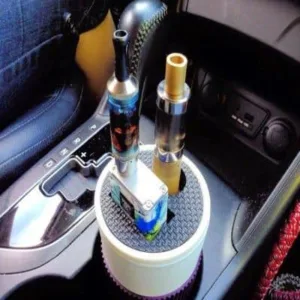Great article looking at the legality of vaping in your car with children.
At least so far, there’s no solid evidence that the mist from electronic cigarettes is dangerous to bystanders – including kids along with you in the car, says researcher Igor Burstyn.
“If you have a kid in your car and they’re feeling sick, what do you do first? You stop the car, you get out of the car and maybe you stop vaping and see whether the kid feels better,” says Burstyn, an associate professor of environmental and occupational health at the Dornsife School of Public Health at Drexel University in Philadelphia. “But to compare it to smoking is utterly ridiculous – it’s like saying that if you have a nerf gun, then you might as well use real bullets because a gun is a gun.”
The Oxford English Dictionary added the word vaping last year – along with sexting, crowdfunding and photobombing. Because electronic cigarettes don’t contain tobacco and don’t emit smoke, when you use them, you vape.
An atomizer heats the juice in the flavour cartridge – water, chemical flavours like Macaron De Paris, Waikiki Watermelon and Oatmeal cookie, propylene glycol and vegetable glycerin – and turns it into vapour.
Unlike cigarettes which produce smoke the whole time they’re lit, e-cigarettes only produce vapour when inhaled.
So far, Health Canada has not regulated e-cigarettes.
“Health Canada is still hiding under their desks on this one,” says University of Ottawa law professor David Sweanor. “They have no regulations in place – no system of disclosures or approvals.”
Under the Food and Drug Act, any product containing nicotine has to be approved by Health Canada before it can be imported, advertised or sold. Because Health Canada hasn’t approved any e-juice containing nicotine, it’s not allowed to be sold here.
“Nicotine is still available – you can get it over the Internet,” says Scott McDonald, CEO of the B.C. Lung Association.
In May, Quebec will be the final province to make it illegal to smoke with kids in cars, says Cynthia Callard, executive director of Physicians for a Smoke-Free Canada. Right now, it’s illegal to smoke in cars with kids under 16 in B.C., Saskatchewan, Manitoba, Ontario, New Brunswick and Newfoundland. In Alberta and the Yukon, that age is 18. In Nova Scotia and Prince Edward Island it’s 19.
While the dangers of second-hand smoke are well known, one in 10 Canadian kids is still exposed to second-hand smoke in cars on a daily basis, Callard says.
But what about vaping with kids in cars?
Vaping in cars with anyone under the age of 19 is banned in Nova Scotia.
In the last year, Manitoba and Ontario have proposed making it illegal to vape with kids in vehicles. So far, those plans have been delayed.
“In the coming months, we will move to restrict where e-cigarettes can be used,” says Ontario Ministry of Health and Long-Term care in an e-mail statement. “As always, we welcome continued input from all stakeholders as we work together to help protect Ontario’s youth from the dangers of tobacco and the potential harms of e-cigarettes.”
Studies have found e-cigarette vapour increases indoor air pollution.
Others have found carcinogens including formaldehyde. Another recent Harvard study tested 51 brands of e-juice and found diacetyl in 47 of them. That chemical had been found in artificial butter flavouring and caused an irreversible lung disease – “popcorn lung” – in workers.
Until there’s more conclusive research on the safety of second-hand vaping, it’s a good idea not to vape in a vehicle if you have kids with you, says the BC Lung Association.
“With vaping, it’s not really known what the contents are – potentially, people are mixing in it up in their garage or in a basement somewhere in China,” says the Lung Association’s McDonald. “There’s very little disclosure of the vaping liquid and when it is disclosed, it’s usually just a long list of chemically-sounding names.”
The Lung Association believes people should inhale nothing except “fresh, clean air,” McDonald says.
Burstyn, who wrote a 2014 paper looking at whether contaminants in e-cigarette vapour exceeded workplace exposure standards, says “we have a pretty good idea what’s in e-cigarettes.”
“There are patents and there have been thousands of analyses,” he says. “These are all known chemicals – some like formaldehyde have been studied for years.”
The levels in e-cig vapour all meet workplace safety limits, Burstyn says.
“If you’re working in a factory and there are these levels in the air, you would not be worried,” Burstyn says. “You and I are inhaling formaldehyde right now as we speak – it does not mean these levels are harmful.”
There’s no evidence that vaping is “100 per cent safe” and there is evidence that the vapour can cause problems for people with pre-existing health conditions, Burstyn says.
But, it’s replacing smoking, which is a known killer, he says.
“It’s nothing like smoking tobacco – it gives that nicotine hit and flavour without the harm and risk of cigarettes,” he says. “I don’t smoke, I don’t vape – I just look at the numbers and see that it reduces smoking and has no discernible harm to bystanders.”
And, in most Canadian cities, you’re breathing in a lot more than clean, fresh air anyway.
“I don’t think e-cigs are adding very much to the risk caused by air pollution,” he says.

